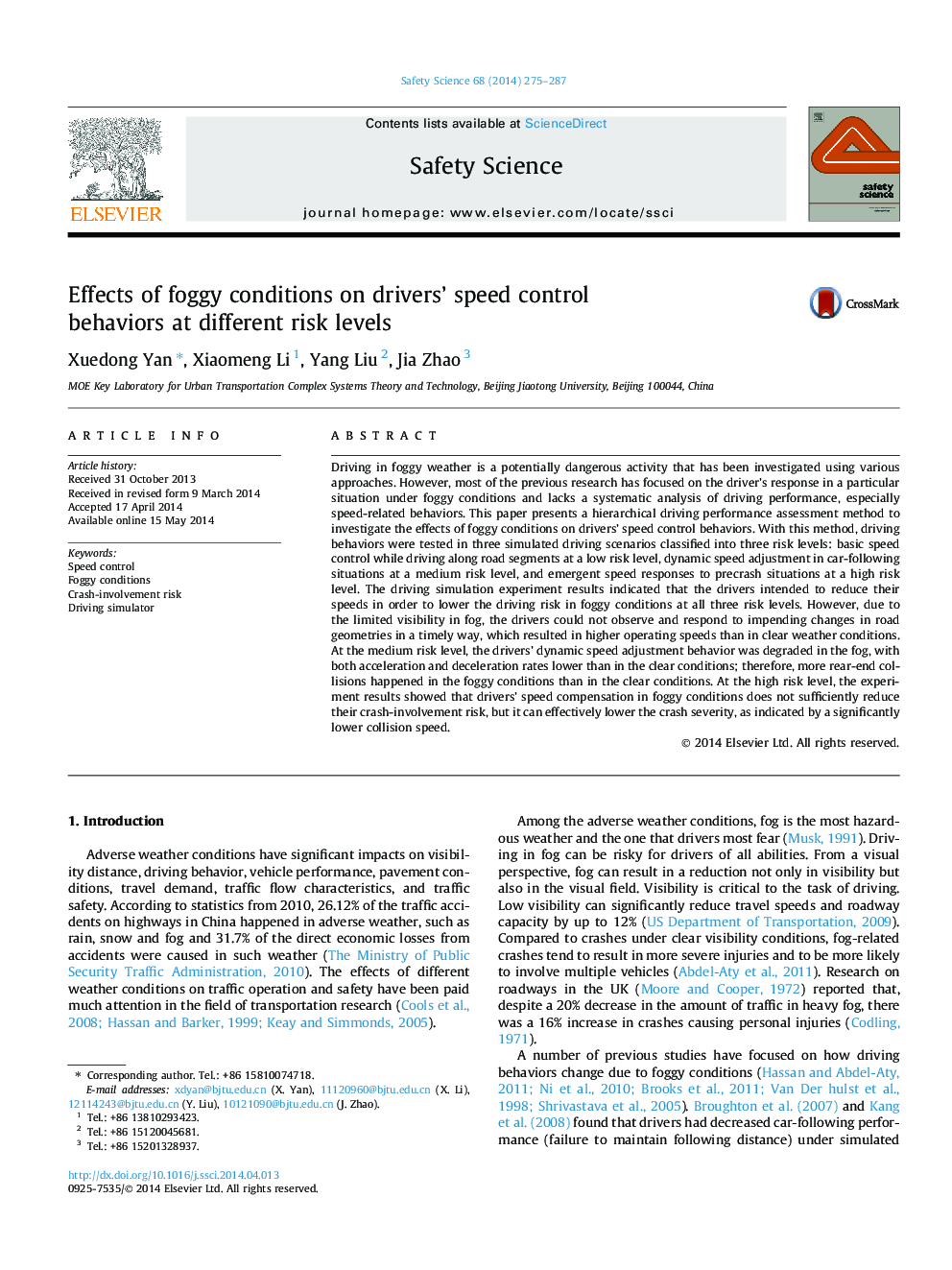| کد مقاله | کد نشریه | سال انتشار | مقاله انگلیسی | نسخه تمام متن |
|---|---|---|---|---|
| 6976285 | 1453402 | 2014 | 13 صفحه PDF | دانلود رایگان |
عنوان انگلیسی مقاله ISI
Effects of foggy conditions on drivers' speed control behaviors at different risk levels
ترجمه فارسی عنوان
تأثیر شرایط مه آلود در رفتار کنترل سرعت رانندگان در سطوح مختلف ریسک
دانلود مقاله + سفارش ترجمه
دانلود مقاله ISI انگلیسی
رایگان برای ایرانیان
کلمات کلیدی
کنترل سرعت، شرایط فضای سبز، خطر سقوط، شبیه ساز رانندگی،
ترجمه چکیده
رانندگی در هوای مه آلود یک فعالیت بالقوه خطرناک است که با استفاده از رویکردهای مختلف مورد بررسی قرار گرفته است. با این حال، بیشتر تحقیقات قبلی بر روی پاسخ راننده در یک وضعیت خاص در شرایط مه بدان متمرکز شده و تجزیه و تحلیل سیستماتیک از عملکرد رانندگی، به ویژه رفتارهای مرتبط با سرعت، نداشته است. این مقاله یک روش ارزیابی عملکرد رانندگی سلسله مراتبی برای بررسی اثرات شرایط مهیج در رفتار کنترل سرعت رانندگان ارائه می دهد. با استفاده از این روش، رفتار رانندگی در سه سناریو رانندگی شبیه سازی شده به سه سطح ریسک تقسیم بندی شد: کنترل سرعت اولیه در هنگام رانندگی در کنار بخش های جاده ها در یک سطح پایین ریز، تنظیم سرعت دینامیکی در شرایط خودرو در سطح ریسک متوسط و سرعت نوظهور واکنش به شرایط پیشگیری در سطح بالا. نتایج آزمایش های رانندگی شبیه سازی نشان می دهد که رانندگان قصد کاهش سرعت خود را برای کاهش خطر رانندگی در شرایط مهمی در هر سه سطح ریسک دارند. با این حال، به دلیل دید محدود در مه، رانندگان قادر به مشاهده به موقع به تغییرات قریب الوقوع هندسه جاده ها نیستند و این به سرعت بیشتر از سرعت هوا در شرایط آب و هوایی منجر می شود. در سطح خطر متوسط، رفتار تعدیل سرعت دینامیکی رانندگان در مه کاهش یافته است، با هر دو سرعت شتاب و کاهش سرعت پایین تر از در شرایط روشن؛ بنابراین بیشتر برخورد های عقب پایان در شرایط مه آلود رخ داد در شرایط روشن است. در سطح بالای ریسک، نتایج آزمایش نشان داد که جبران سرعت رانندگان در شرایط مهمی به اندازه کافی خطر سقوط خود را کاهش نمی دهد، اما می تواند شدت سقوط را به طور موثر کاهش دهد، همانطور که با سرعت بسیار پایین برخورد می شود.
موضوعات مرتبط
مهندسی و علوم پایه
مهندسی شیمی
بهداشت و امنیت شیمی
چکیده انگلیسی
Driving in foggy weather is a potentially dangerous activity that has been investigated using various approaches. However, most of the previous research has focused on the driver's response in a particular situation under foggy conditions and lacks a systematic analysis of driving performance, especially speed-related behaviors. This paper presents a hierarchical driving performance assessment method to investigate the effects of foggy conditions on drivers' speed control behaviors. With this method, driving behaviors were tested in three simulated driving scenarios classified into three risk levels: basic speed control while driving along road segments at a low risk level, dynamic speed adjustment in car-following situations at a medium risk level, and emergent speed responses to precrash situations at a high risk level. The driving simulation experiment results indicated that the drivers intended to reduce their speeds in order to lower the driving risk in foggy conditions at all three risk levels. However, due to the limited visibility in fog, the drivers could not observe and respond to impending changes in road geometries in a timely way, which resulted in higher operating speeds than in clear weather conditions. At the medium risk level, the drivers' dynamic speed adjustment behavior was degraded in the fog, with both acceleration and deceleration rates lower than in the clear conditions; therefore, more rear-end collisions happened in the foggy conditions than in the clear conditions. At the high risk level, the experiment results showed that drivers' speed compensation in foggy conditions does not sufficiently reduce their crash-involvement risk, but it can effectively lower the crash severity, as indicated by a significantly lower collision speed.
ناشر
Database: Elsevier - ScienceDirect (ساینس دایرکت)
Journal: Safety Science - Volume 68, October 2014, Pages 275-287
Journal: Safety Science - Volume 68, October 2014, Pages 275-287
نویسندگان
Xuedong Yan, Xiaomeng Li, Yang Liu, Jia Zhao,
